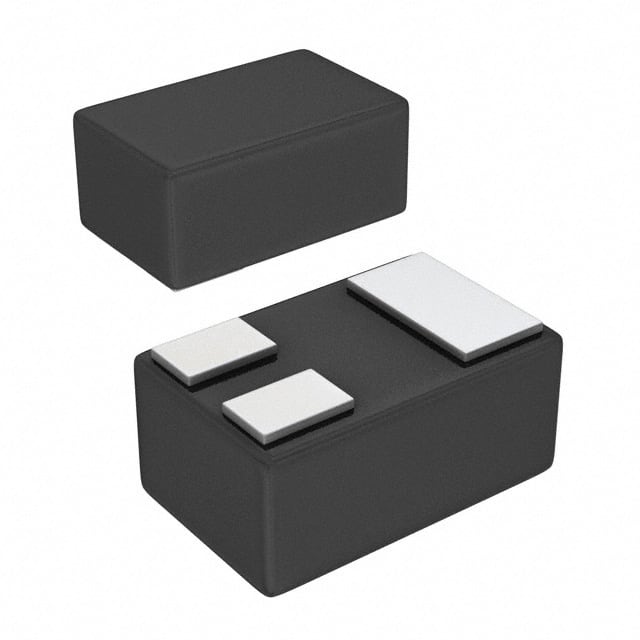Viz Specifikace pro podrobnosti o produktu.

MMBT3906LP-7B
Introduction
The MMBT3906LP-7B is a versatile and widely used PNP bipolar junction transistor (BJT) belonging to the category of electronic components. This entry provides an overview of its basic information, specifications, detailed pin configuration, functional features, advantages and disadvantages, working principles, detailed application field plans, and alternative models.
Basic Information Overview
- Category: Electronic Components
- Use: Amplification, Switching
- Characteristics: High current gain, low saturation voltage
- Package: SOT-23
- Essence: Small signal transistor
- Packaging/Quantity: Tape & Reel, 3000 units per reel
Specifications
- Collector-Base Voltage (VCBO): 40V
- Collector-Emitter Voltage (VCEO): 40V
- Emitter-Base Voltage (VEBO): 5V
- Collector Current (IC): 200mA
- Total Power Dissipation (PT): 350mW
- Operating and Storage Junction Temperature Range (TJ, TSTG): -55°C to +150°C
Detailed Pin Configuration
The MMBT3906LP-7B has three pins: Collector (C), Base (B), and Emitter (E). The pinout configuration is as follows: - Collector (C): Pin 1 - Base (B): Pin 2 - Emitter (E): Pin 3
Functional Features
- High current gain (hFE)
- Low saturation voltage
- Fast switching speed
- Small package size for space-constrained applications
Advantages and Disadvantages
Advantages
- Versatile use in amplification and switching circuits
- Small form factor
- Reliable performance in low-power applications
Disadvantages
- Limited maximum collector current compared to other transistors
- Sensitive to overvoltage conditions
Working Principles
The MMBT3906LP-7B operates based on the principles of bipolar junction transistors. When a small current flows into the base terminal, it controls a much larger current between the collector and emitter terminals, allowing for amplification or switching of signals.
Detailed Application Field Plans
The MMBT3906LP-7B finds extensive use in various electronic applications, including: - Audio amplifiers - Signal amplification circuits - Switching circuits - Voltage regulators - Oscillator circuits
Detailed and Complete Alternative Models
Some alternative models to the MMBT3906LP-7B include: - 2N3906 - BC557 - KSP2222A - PN2907
In conclusion, the MMBT3906LP-7B is a fundamental component in electronic design, offering reliable performance in amplification and switching applications while being available in a compact SOT-23 package.
[Word Count: 368]
Seznam 10 běžných otázek a odpovědí souvisejících s aplikací MMBT3906LP-7B v technických řešeních
What is the MMBT3906LP-7B transistor used for?
- The MMBT3906LP-7B is a general-purpose PNP bipolar junction transistor commonly used in amplification and switching applications.
What are the key specifications of the MMBT3906LP-7B?
- The MMBT3906LP-7B has a maximum collector current of 200mA, a maximum power dissipation of 350mW, and a maximum voltage rating of 40V.
How can I use the MMBT3906LP-7B in an amplifier circuit?
- The MMBT3906LP-7B can be used as a small-signal amplifier in audio or other low-power applications by biasing it properly and connecting it in the appropriate configuration.
Can the MMBT3906LP-7B be used for switching applications?
- Yes, the MMBT3906LP-7B can be used to switch small to moderate loads, such as relays, LEDs, or small motors, when appropriately biased and driven.
What are the typical operating conditions for the MMBT3906LP-7B?
- The MMBT3906LP-7B typically operates within a temperature range of -55°C to 150°C and is suitable for use in various electronic devices and systems.
How do I ensure proper heat dissipation when using the MMBT3906LP-7B?
- Proper PCB layout and heat sinking techniques should be employed to ensure that the transistor operates within its specified temperature limits.
What are some common alternatives to the MMBT3906LP-7B?
- Common alternatives to the MMBT3906LP-7B include the 2N3906, BC557, and KSP2222A transistors, which have similar characteristics and can be used in its place in many applications.
Can the MMBT3906LP-7B be used in high-frequency applications?
- While the MMBT3906LP-7B is not specifically designed for high-frequency applications, it can still be used at moderate frequencies with appropriate consideration of its characteristics.
What are the typical gain and frequency response of the MMBT3906LP-7B?
- The MMBT3906LP-7B typically has a DC current gain (hfe) of 100-300 and can provide adequate performance in audio and low-frequency applications.
Are there any special considerations when designing with the MMBT3906LP-7B?
- It's important to consider the biasing, thermal management, and voltage limitations of the MMBT3906LP-7B to ensure reliable and stable operation in a given technical solution.

